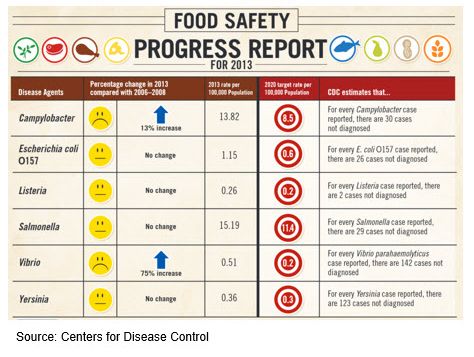WASHINGTON, May 20, 2015 – There’s some good news and bad news in the latest report on foodborne illnesses from the Centers for Disease Control and Prevention.
The good news: rates of infection from the E. coli 0157 bacteria and one of the more common Salmonella serotypes are falling. At the same time, some other less common types of Salmonella are increasing, as are infections from other bacteria including Campylobacter and Vibrio.
“We’re cautiously optimistic that changes in food safety practices are having an impact in decreasing E. coli and we know that without all the food safety work to fight Salmonella that more people would be getting sick with Salmonella than we are seeing now,” said Robert Tauxe, deputy director of CDC’s Division of Foodborne, Waterborne and Environmental Diseases. “The increasing use of whole genome sequencing to track foodborne illness cases will also help; however, much more needs to be done to protect people from foodborne illness.”
The data are from FoodNet, CDC’s active surveillance system that tracks nine common foodborne pathogens in 10 states and monitors trends in foodborne illness in about 15 percent of the U.S. population. The report compares the 2014 frequency of infection per 100,000 population with the frequency in the baseline period 2006-2008 and in the three most recent years. FoodNet logged just over 19,000 confirmed infections in the 10 states, resulting in 4,400 hospitalizations, and 71 deaths from the nine foodborne germs it tracks. Salmonella and Campylobacter were by far the most common– accounting for about 14,000 of the 19,000 infections reported.
The rate of infections from E. coli O157, which can sometimes lead to kidney failure, decreased 32 percent when compared with 2006-2008 and 19 percent when compared with the most recent three years. These infections are often linked to consumption of undercooked ground beef and raw leafy vegetables.
Salmonella Typhimurium, which has been linked to poultry, was 27 percent lower than it was in 2006-2008, continuing a downward trend begun in the mid-1980s, the CDC said. Two other less common types of Salmonella, Javiana and Infantis, more than doubled for reasons that are unclear, the agency said. Salmonella Javiana is concentrated in the southeastern United States, but has been spreading within the Southeast and to other areas of the country. However, when all Salmonella serotypes are combined, there was no change in 2014.

The recent decline in the incidence of Shiga-toxin producing E. coli O157 follows several years of increasing scrutiny for beef products. CDC pointed out that since 1994, USDA’s Food Safety Inspection Service (FSIS) has taken the bacterium extremely seriously and made a number of changes in its regulatory oversight of the beef industry to protect public health.
"We are encouraged by the reduction of (E. coli) illnesses, which reflects our science-based approach to beef inspection, and we look forward to seeing further reductions in Salmonella and Campylobacter infections as our improved standards for poultry take effect later this year,” said Al Almanza, USDA’s deputy under secretary for food safety.” Data sources like FoodNet allow us to be strategic in developing our food safety policies, and we will do everything within our power to keep reducing cases of foodborne illness from all meat and poultry products."
The North American Meat Institute (NAMI) said it was pleased with the latest CDC data but stressed that there is more work to do to reduce foodborne illness rates from all food.
“The CDC data is another strong indication that industry and government efforts are working to reduce foodborne illnesses from major pathogens of concern which is consistent with major declines in pathogen rates we’ve seen on meat and poultry products in recent years,” Betsy Booren, NAMI vice president of scientific affairs, said in a news release. “We’re committed to working with the government to continue these improvements and seek out ways to lower foodborne illnesses across all foods.”
According to NAMI, recent reductions in pathogen rates on meat and poultry products include a 93 percent reduction of E. coli in ground beef since 2000. There has also been significant reductions in Salmonella across a majority of meat and poultry products and a greater than 80 percent reduction in Listeria monocytogenes in ready-eat-meat products, NAMI said, adding that there has not been a federal recall related to listeriosis associated with meat and poultry products in more than a decade.
The NAMI Foundation has a Food Safety Initiative with a goal to reduce and ultimately eradicate Listeria monocytogenes on ready-to-eat meat and poultry products, Shiga toxin-producing E. coli in fresh beef, and Salmonella in meat and poultry products. NAMI says that since the Initiative was launched in 1999, its Foundation has funded nearly $9 million dollars in food safety research projects aimed at identifying practical food safety strategies.
CDC estimates that each year roughly 1 in 6 Americans (or 48 million people) get sick, 128,000 are hospitalized, and 3,000 die of foodborne diseases. Olga Henao, team leader for FoodNet, explained that the CDC numbers are estimates for the entire country, whereas FoodNet’s numbers for illnesses, hospitalizations and deaths are reported and confirmed cases in just a 10 state area. Dr. Patricia Griffin, with the CDC’s division of foodborne disease said the real number of infections is likely much larger, however, because many people with foodborne infections are never tested. Griffin estimates that for every person with a lab-confirmed case of Salmonella, for example, there are about 29 other people who also had the infection but were not tested.
#30
For more news, go to www.agri-pulse.com.

